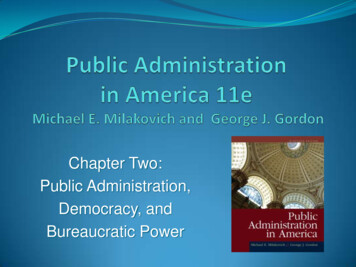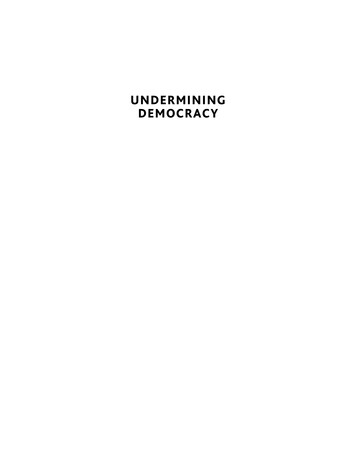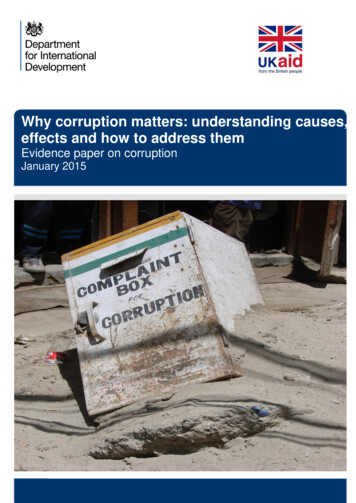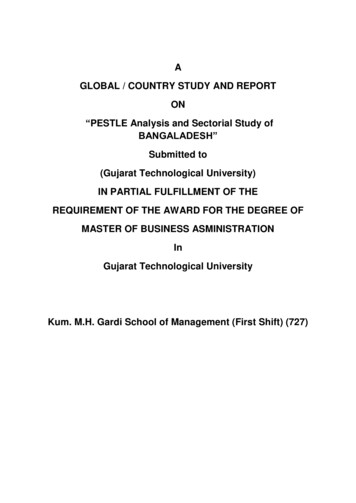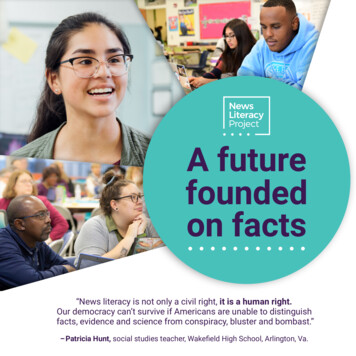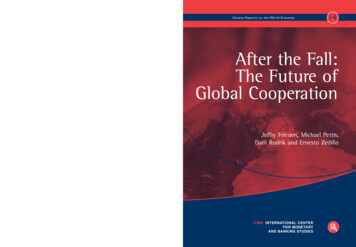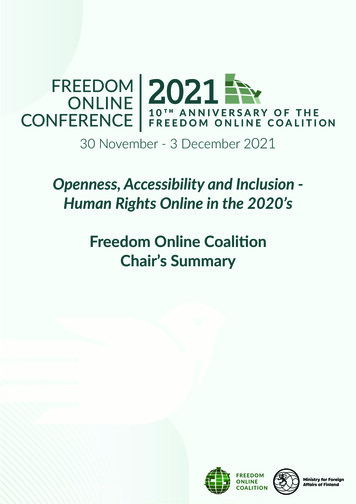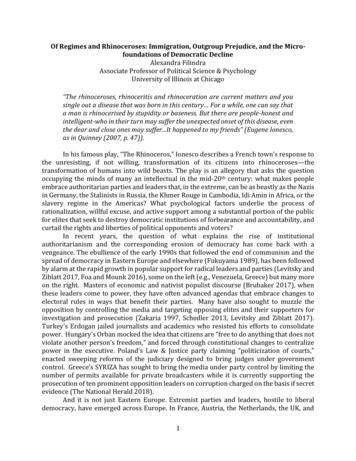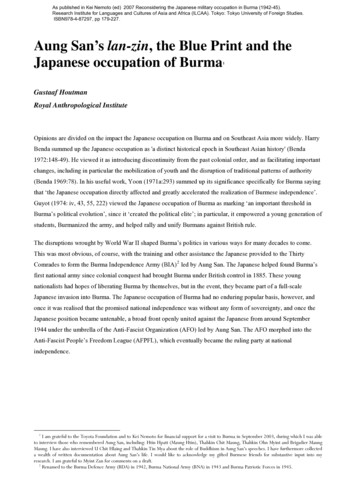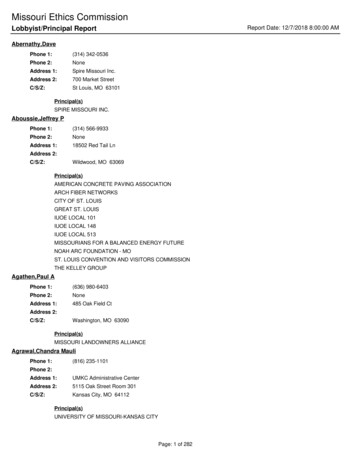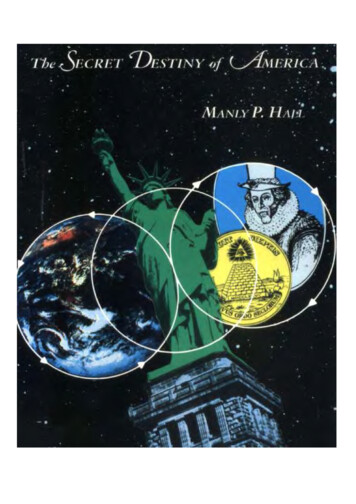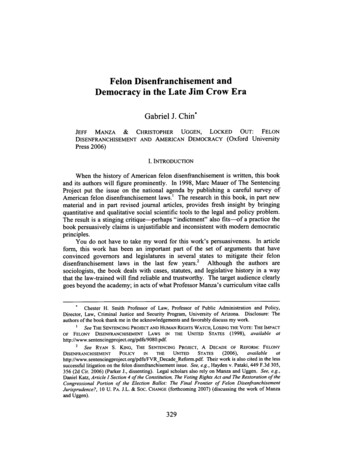
Transcription
Felon Disenfranchisement andDemocracy in the Late Jim Crow EraGabriel J. Chin*FELONLOCKED OUT:JEFF MANZA & CHRISTOPHER UGGEN,DISENFRANCHISEMENT AND AMERICAN DEMOCRACY (Oxford UniversityPress 2006)I. INTRODUCTIONWhen the history of American felon disenfranchisement is written, this bookand its authors will figure prominently. In 1998, Marc Mauer of The SentencingProject put the issue on the national agenda by publishing a careful survey ofAmerican felon disenfranchisement laws.' The research in this book, in part newmaterial and in part revised journal articles, provides fresh insight by bringingquantitative and qualitative social scientific tools to the legal and policy problem.The result is a stinging critique-perhaps "indictment" also fits-of a practice thebook persuasively claims is unjustifiable and inconsistent with modem democraticprinciples.You do not have to take my word for this work's persuasiveness. In articleform, this work has been an important part of the set of arguments that haveconvinced governors and legislatures in several states to mitigate their felondisenfranchisement laws in the last few years.2 Although the authors aresociologists, the book deals with cases, statutes, and legislative history in a waythat the law-trained will find reliable and trustworthy. The target audience clearlygoes beyond the academy; in acts of what Professor Manza's curriculum vitae callsChester H. Smith Professor of Law, Professor of Public Administration and Policy,Director, Law, Criminal Justice and Security Program, University of Arizona. Disclosure: Theauthors of the book thank me in the acknowledgements and favorably discuss my work.*See THE SENTENCING PROJECT AND HUMAN RIGHTS WATCH, LOSING THE VOTE: THE TES(1998),available INGTHEPROJECT,UNITEDADECADE OFSTATES(2006),REFORM: pdfs/FVRDecadeReform.pdf. Their work is also cited in the lesssuccessful litigation on the felon disenfranchisement issue. See, e.g., Hayden v. Pataki, 449 F.3d 305,356 (2d Cir. 2006) (Parker J., dissenting). Legal scholars also rely on Manza and Uggen. See, e.g.,Daniel Katz, Article I Section 4 of the Constitution, The Voting Rights Act and The Restoration of theCongressional Portion of the Election Ballot: The Final Frontier of Felon DisenfranchisementJurisprudence?, 10 U. PA. J.L. & SOC. CHANGE (forthcoming 2007) (discussing the work of Manzaand Uggen).
OHIO STATE JOURNAL OF CRIMINAL LAW[Vol 5:329"public sociology," the authors have taken their research to the public throughdozens of editorials, media appearances, and interviews.At its core, the policy of criminal disenfranchisement is close to uniform:among the fifty states, Maine and Vermont stand alone in refusing todisenfranchise those in prison. Beyond that, states vary widely over whether thoseon probation or parole are disenfranchised, and whether fines and assessmentsmust be paid in full, even if that means an ex-convict, who typically will havelimited employment prospects, may be effectively disenfranchised for life. Themost important controversy is about those who have "paid their debt," thoseconvicted of felonies but who are out, off parole and probation, and have paid allfines and assessments. Florida, Kentucky, and Virginia disenfranchise suchpersons with felony records for life; about ten other states have some limitation forthose who are completely free of correctional control--a waiting period beforerights are restored, lifetime disenfranchisement for repeat offenders, or lifetimedisenfranchisement for those convicted of certain crimes. Of course, each statedecides for itself how it treats a person with a conviction, even an out-of-stateconviction, so it is perfectly possible that a person who can vote in New Yorkdespite a New York conviction will find herself disenfranchised if she moves toArizona, or vice-versa.It might be said that felon disenfranchisement is a folkway rather than apolicy; it enjoys remarkably wide acceptance in codes across the country without awell-articulated justification or rationale, particularly for the period after fullcompletion of sentence. The book is designed, I think, to reflect the authors'conclusion that there is no reasonable justification for the policy; they would liketo see "reconsideration of all voting restrictions on disenfranchised felons."(Manza & Uggen, p. 228.) They believe that "even the disenfranchisement ofcurrent inmates is problematic." (Manza & Uggen, p. 231.)Felon disenfranchisement lies at the intersection of three distinct areas of law.First, while not regarded as "punishment" for due process purposes, it has acriminal law/sentencing component, as part of the package of sanctionsautomatically following criminal conviction. Accordingly, like loss of other rights(e.g., to possess a firearm, to obtain or retain public benefits, licenses oreducational opportunities, and, for non-citizens, to live in this country), felondisenfranchisement just happens upon conviction.3 No one has to tell a defendantabout it before pleading guilty, or to put it another way, before deciding whether itis really smarter to mortgage one's house and fight the case even though theprosecutor offered a walk-away deal. 4 (It is the allegedly non-punitive nature offelon disenfranchisement that forecloses its legitimation on the ground that it is3See, e.g.,AM. BAR Ass'N, CRIMINAL JUSTICE STANDARDS: COLLATERAL SANCTIONS ANDOF CONVICTED PERSONS(3d ed. 2004), available raltoc.html.4See, e.g., Gabriel J. Chin & Richard W. Holmes, Jr., Effective Assistance of Counsel andthe Consequences of Guilty Pleas, 87 CORNELL L. REV. 697 (2002).DISCRETIONARYDISQUALIFICATION
2007]FELONDISENFRANCHISMENTpunishment for crime-if punishment, then the judge must disclose it at the time ofthe guilty plea.)The "gotcha" nature of disenfranchisement raises fairness issues. From asentencing perspective, the institution begs the question of what, exactly,disenfranchisement is supposed to do to advance the goals of the criminal justicesystem. Rather than being a natural, inevitable feature of any mature system ofcriminal justice, denying large numbers of citizens with felony convictions theright to vote is virtually unique to the United States. (Manza & Uggen, pp. 38-39,235.) This question is all the more important given the practical problem ofreintegrating an increasing number of individuals who have served time in prison.Second, felon disenfranchisement is part of race law. The disenfranchisementlaws of several of the former Confederate states in particular bear the clear imprintof a purpose to maintain white supremacy. A remarkable example is the candiddecision of a unanimous Mississippi Supreme Court which, in Ratliff v. Beale,5explained the origins of the Mississippi Constitution of 1890, still in force today:Our unhappy state had passed in rapid succession from civil war througha period of military occupancy, followed by another, in which the controlof public affairs had passed to a recently enfranchised race, unfitted byeducational experience for the responsibility thrust upon it. This wassucceeded by a semimilitary, semicivil uprising, under which the whiterace, inferior in number, but superior in spirit, in governmental instinct,and in intelligence, was restored to power. 6To cement its power, the dominant group structured the constitution to ensurepermanent white supremacy: "Within the field of permissible action under thelimitations imposed by the federal constitution, the convention swept the circle ofexpedients to obstruct the exercise of the franchise by the negro race. ' 7 Thisincluded employment of felon disenfranchisement: Because the state constitutioncould not discriminate against African-Americans directly, "the conventiondiscriminated against its characteristics and the offenses to which its weakermembers were prone .Burglary, theft, arson, and obtaining money under falsepretenses were declared to be disqualifications, while robbery and murder andother crimes . were not."8Third, felon disenfranchisement is part of election law and voting rightsjurisprudence. Ideally, policies allowing some to vote and others not should bebased on legitimate and justifiable reasons. A glance at, for example, the postCivil War constitutional amendments shows that expanding access to the ballot620 So. 865 (Miss. 1896).Id. at 867.7Id. at 868.8Id.5
OHIO STATE JOURNAL OF CRIMINAL LAW[Vol 5:329was the single most important reason the Constitution-in-being was found to beunsatisfactory: The Fourteenth, Fifteenth, Seventeenth, Nineteenth, Twenty-third,Twenty-fourth and Twenty-sixth Amendments expanded the franchise to newgroups, or, in the case of direct election of Senators, the ballot's value. If theunlamented demise of qualifications based on sex, race, and property begins tosuggest an underlying principle of universal adult franchise, then the exclusion of aparticular group, those with felony convictions, calls for a justification.The book's ambitious claim is that as criminal justice policy, as race policy,and as electoral policy, felon disenfranchisement is not only unjustifiable, butmight well be affirmatively harmful measured against relatively uncontroversialpolicy goals.II. CRIMINAL JUSTICE POLICYReducing crime is the most important, or one of the most important, goals ofthe criminal justice system. One of the book's most startling suggestions is thepossibility that felon disenfranchisement actually increases crime. The bookproposes a link between civic participation in the form of voting and desistencefrom crime. At one level, this makes perfect sense; those convicted of crimes havetransgressed the laws of society; they must "pay their debf' and in so doing restoretheir place in society. In states allowing those who have paid their debt to vote, itwould seem to be a positive sign that an individual demonstrates attachment to thecommunity by performing his or her civic duty at the ballot box as well as in otherways. Someone who has a stake in making the laws, common sense suggests,might be less likely to break them.The authors test this notion empirically by correlating voting and subsequentcriminal behavior.Their data for this conclusion come from the YouthDevelopment Study, a longitudinal examination of 1,010 individuals in St. PaulMinnesota who where in the ninth grade when first surveyed in 1987-88.Participants were surveyed repeatedly over time about their behavior and attitudes.(Manza & Uggen, p. 256.)For those with criminal records and without, voting reduced future criminalinvolvement. Of those who voted in 1996, 5.2 per one thousand were arrested, and4.7 per thousand were incarcerated in 1997-2000; of those who did not vote, thearrest rate was 15.6 per thousand and the incarceration rate 12.4 per thousand.Separating these statistics into those with and without prior criminal recordsshowed the same effect. Of those with prior arrest records, 26.6 per thousand ofnon-voters were rearrested, while only 12.1 per thousand of voters were rearrested.Of those with no arrest history, 10.1 per thousand of non-voters were arrested,while only 3.5 per thousand of voters were arrested. The correlation betweenvoting and law-abiding behavior held when using self-reports of criminal behavior:Those who voted were much less likely to admit having committed a property orviolent crime for which they were not arrested than those who failed to performtheir civic duty. (Manza & Uggen, pp. 132-33.)
2007]FELON DISENFRANCHISMENTThe authors acknowledge that their data are suggestive rather than conclusive,and, as is characteristic of this book, they identify the potential infirmities of thehypothesis; controlling for other characteristics such as race and sex explains muchof the difference of the criminal justice involvement between voters and nonvoters. Nevertheless, the potential connection is intriguing and intuitivelyplausible. Just as, caeteris paribus, those who feel like they are part of societymay be more likely to follow its rules, individuals who get the message that theyare outsiders forever might feel less moral constraint from laws they can neverinfluence.The data showed that those who had been arrested or incarcerated were lesslikely to claim affiliation with any political party than those who had never hadcontact with the criminal justice system; that is, a greater percentage wereindependent rather than Republican or Democratic. (Manza & Uggen, p. 119.)They were more cynical about government, their own role in influencing publicpolicy, and were less likely to talk politics with friends and family than those whoremained free of criminal entanglement. (Manza & Uggen, pp. 120-22.) Ratherthan criminals tending to be uninterested in politics, the data raise the possibilitythat political disengagement or exclusion breeds crime. "If those who vote areactually less likely to commit new crimes, extending the franchise may facilitatereintegration efforts and perhaps even improve public safety." (Manza & Uggen,p. 129.)Another argument based on criminal justice policy has been that exclusion ofconvicted persons is necessary to avoid radical, undesirable changes in ourcriminal laws. Judge Henry Friendly rejected an equal protection challenge tofelon disenfranchisement on this basis: "A contention that the equal protectionclause requires New York to allow convicted mafiosi to vote for district attorneysor judges would not only be without merit but as obviously so as anything canbe." 9 There are many possible responses to this concern, the most obvious onebeing that it is quite unlikely that even the most carefully orchestrated politicalcampaign by people with felony records would lead to repeal of RICO or reductionof the age of consent.Chapter 6 offers an additional reason why fear of a public policy orientedtoward the preferences and interests of criminals is unrealistic, based on the resultsof a qualitative study consisting of interviews with individuals in prison, on parole,or on probation. There was little support for radical changes to the criminal justicesystem: "[N]one of our respondents expressed extreme views about eliminating orfundamentally transforming the system. In fact, a number highlighted instead thenew knowledge they had gained in prison about just how bad other criminals are."(Manza & Uggen, p. 144.)9Green v. Bd. of Elections of the City of N.Y., 380 F.2d 445, 451-52 (2d Cir. 1967).
OHIO STATE JOURNAL OF CRIMINAL LAW[Vol 5:329There were also a surprising number of self-described conservatives.Saidone:I was a liberal Democrat most of my life, but due to my problems I haveto be conservative 'cause I can't cope with my problems and be liberal .like when I got drunk and became sexual act-, sexually prone, you know?. But being, switching to conservatism, now I, you know, I have to beconservative 'cause I- With my medications and stuff, and my mentalproblems, if-without being conservative, I'll be in trouble. (Manza &Uggen, p. 147.)Similarly, a prisoner with a murder rap explained: "One thing that wouldmake me lean toward the Republican viewpoint is their, they think that, you know,the government shouldn't have so much money and, you know, shouldn't be as bigas it is and have so much power and authority, which all really comes from money,I guess." (Manza & Uggen, p. 149.)At bottom, "[flar from being the politically deviant or incompetent citizensimagined by those who would protect the 'purity' of the ballot box, they expressedthe same types of political hopes and fears, and policy preferences, as otherenfranchised groups." (Manza & Uggen, p. 151.) "Our interviews also suggestedan interaction between the right to vote and the willingness to invest in politicalknowledge, awareness, or interest, which might stimulate participation in the firstplace."(Manza & Uggen, p. 157.)"They clearly felt the sting ofdisenfranchisement and other collateral consequences of their convictions, whichmarked them as outsiders." (Manza & Uggen, p. 163.)It is a profound decision to hold that those convicted of crime, even relativelyminor crimes a long time ago, can never regain their places as full and equalmembers of society. As Justice Anthony Kennedy said in his remarkable speech tothe American Bar Association in 2003, in which he criticized mass incarceration,mandatory minimum sentences, and the absence of discretion:To be sure the prisoner has violated the social contract; to be sure hemust be punished to vindicate the law, to acknowledge the suffering ofthe victim, and to deter future crimes. Still, the prisoner is a person; still,he or she is part of the family of humankind.' III. RACIAL POLICYA major contention of the book is that felon disenfranchisement is an artifactof Jim Crow. Admittedly, the argument is not simple; Louisiana's 1845 felon10 Anthony M. Kennedy, Associate Justice, Supreme Court of the United States, Address atthe American Bar Association Annual Meeting (Aug. 9, 2003), in 16 FED. SENT'G. REP. 126, 127(2004).
2007]FELONDISENFRANCHISMENT335disenfranchisement law, for example, cannot possibly have been designed as acovert measure against African-Americans, because other provisions of lawdisenfranchised them explicitly. Felon disenfranchisement clearly was notinvented as a tool of oppression of African-Americans.However, traditional legal and historical techniques have generated strongevidence of discriminatory intent in particular states at particular times, mostparticularly in the former Confederate states. The authors recount some of thishistory. In Hunter v. Underwood,1 for example, a unanimous Supreme Court, inan opinion written by then Associate Justice Rehnquist, invalidated Alabama'sfelon disenfranchisement provision because it was designed to disenfranchiseOther states' disenfranchisement provisions also reflectAfrican-Americans.evidence of intent to disenfranchise African-Americans. "Disenfranchisementbased on criminal conviction provided a useful, and potentially permanent, way toeliminate voters, particularly in light of corresponding changes to the criminaljustice system (which became both more expansive and more formalized duringthe mid- to late nineteenth century)." (Manza & Uggen, p. 57.) "In Alabama, forexample, nonwhites made up just 2 percent of the prison population in 1850, but74 percent by 1870." (Manza & Uggen, p. 57.) "John Fielding Bums, sponsor ofthe new disenfranchisement bill, boasted that 'the crime of wife-beating alonewould disqualify sixty percent of the Negroes."' (Manza & Uggen, p. 58.)The authors' special contribution here is a quantitative analysis. Theydemonstrate racial motivation through equations, not anecdotes. Using "eventhistory analysis," they identify the circumstances which led states to adopt adisenfranchisement law in the period 1850 to 2002. They "developed a systematicquantitative analysis that uses detailed information on the social and politicalmakeup of individual states over a long historical period to examine how variousfactors affect the adoption and extension of state disenfranchisement laws."(Manza & Uggen, pp. 43-44.)Their conclusion: "Racial threat, as measured by the percentage of nonwhitesin state prisons, is clearly associated with adoption [sic] of state felondisenfranchisement laws." (Manza & Uggen, p. 64.) That is, "[w]hen AfricanAmericans make up a larger proportion of a state's prison population, that state issignificantly more likely to adopt or extend felon disenfranchisement." (Manza &Uggen, p. 67.)The authors are skeptical of an approach that I happen to love, namely, "legaland doctrinal analyses of court decisions, or [examination of] anecdotal historicalevidence." (Manza & Uggen, p. 43.) At least, they do not think these materials tellthe whole story. They are right, of course, but the reasons for laws include,centrally, the reasons that can be gleaned from the legislative history and otherevidence of legislative motivation, legitimate or not; and the reasons for case lawoften include those articulated in the court decisions. With laws passed or cases11 471U.S. 222 (1985).
OHIO STATE JOURNAL OF CRIMINAL LAW[Vol 5:329decided in the age of honesty about racism, there is little reason to discount frank,proud, and unambiguous assertions of racial motivation.Nevertheless, this research is a contribution: Although numbers andcorrelations are bloodless, and therefore sometimes less appalling and startlingthan a racist tirade by a Jim Crow-era chief justice or state constitutionalconvention president, quantitative analysis presents less risk that conclusions couldbe skewed by unrepresentative but dramatic incidents. In any event, the evidencefrom traditional legal materials point in the same direction as the authors'statistical analysis: Race drives felon disenfranchisement.The racial motivation for the laws' enactment is realized in their operation."[Iln 14 states, more than 1 in 10 African Americans have lost the right to vote byvirtue of a felony conviction, and 5 of these states disqualify over 20 percent of theAfrican American voting age population." (Manza & Uggen, p. 79.)Why not just apply for clemency or restoration of rights? In somejurisdict* ns, that may be a realistic hope, but in others it is practically impossible.In ally event, the book offers empirical evidence that the system is stacked.Another statistical analysis reports on the operation of Florida's process:African Americans are significantly less likely to have their rightsrestored, as are those of lower socioeconomic status, those who are notmarried, and those who do not own their homes. Further, people with ahistory of mental health treatment are less likely to regain their rights.Differences in criminal history account for some portion of thesedifferences, but do not fully account for the race and class effects onrestoration outcomes. (Manza & Uggen, p. 93.)The authors look to racial politics for an explanation of larger trends incriminal justice. Chapter 4 contends that the rise in imprisonment and prosecutionis not explained by increasing rates of crime. "If crime rates cannot account forrecent trends in punishment practice, then we must look to political and culturalfactors." (Manza & Uggen, p. 105.) The major one: "[T]he reemergence of asharp link between race and crime." (Manza & Uggen, p. 106.) In addition, theWar on Drugs explains why imprisonment has been going up while crime has not."Twenty years on, it is clear that the campaign has done little to influence actualdrug use, but it has been a remarkable political success story." (Manza & Uggen,p. 107.)The nightly news programs aggressively cover crime stories,exaggerating the problem and feeding public fears. And widespreadmedia depictions of the race of offenders are thus particularly importantin the overall story and in magnifying public fears. Although AfricanAmericans may commit proportionately more crimes than whites, mediacoverage vastly exaggerates the extent to which blacks are perpetrators.
2007]FELON DISENFRANCHISMENTA political and cultural model that incorporates race is likely the bestexplanation for rising levels of criminal punishment in the United States.(Manza & Uggen, p. 109.)IV. ELECTORAL POLICYWhen men wore powdered wigs and knee breeches, felon disenfranchisementwas entirely consistent with an elite franchise, restricted as well by race, sex andwealth. Now, however, voting is thought of as a "right" enjoyed by all adults.Felon disenfranchisement still might not be discordant if crime was crime:disenfranchising those committing a common law felony might be thought of asalmost liberal; rapists, robbers and murderers will always, mercifully, be a smallfraction of the population, so disenfranchising them does not raise a significantpractical challenge to universal suffrage. Moreover, for crimes that until recentlycarried a sentence of death, 2 a term of years plus disenfranchisement is notnecessarily draconian. But people are disenfranchised for minor felonies as well asgrave ones, and business in the felony courts has been brisk. Disenfranchising asubstantial portion of the population for relatively trivial offenses is potentiallyinconsistent with the idea of representative government.Chapter 3 attempts to calculate the number of those disenfranchised becauseof criminal conviction. The very exercise is a stark reminder of the ad hoc anddiverse nature of America's electoral system. The book cannot merely pass alonginformation about the number of citizens ineligible to vote, from some governmentsource or collection of sources, because official statistics are not maintained,anywhere, apparently.The book recounts familiar yet still sobering statistics: In 2002, almost a thirdof criminal convictions were for drug offenses; less than a fifth for violent crimes.Eight percent involved rape, robbery or murder. (Manza & Uggen, p. 70.) In1972, fewer than 200,000 people were in prison in the country and the rate ofincarceration was 94 per 100,000; in that year, the problem of felondisenfranchisement could, whatever its merits, plausibly have been regarded as deminimis in the context of the electorate as a whole. (Manza & Uggen, p. 71.) By2006, over 2,000,000 were in custody, for a rate of 714 per 100,000. Of course,these numbers are "highly concentrated among some subgroups." (Manza &Uggen, p. 71.) But to find the total number of disenfranchised individuals, onecannot just add up the number of felony dispositions per year, because not all ofthose convictions will be disenfranchising under the particular terms of that state'slaw, some of those individuals will already have disqualifying convictions, otherswill have died after conviction and thus no longer be counted among the12 Brookman v. Commonwealth, 145 S.E. 358 (Va. 1928) (affirming death sentence forcommon law robbery); Boston & Worcester R.R. Corp. v. Dana, 67 Mass. 83, 97 (1854) ("By theancient common law, felony was punished by the death of the criminal, and the forfeiture of all hislands and goods to the crown.").
OHIO STATE JOURNAL OF CRIMINAL LAW[Vol 5:329disenfranchised, and others will move to states where their conviction is notdisenfranchising or will be granted clemency or have their rights restored.With appropriate legal and factual adjustments, the book concludes that onElection Day 2004, 5.3 million Americans were disenfranchised because of acriminal conviction, namely, 2.5% of the voting age population. (Manza & Uggen,p. 76.) Of these, 26% were in prison, and the largest group, 39%, had completedincarceration, probation and parole. (Manza & Uggen, p. 77.)If Americans as a whole are relatively apathetic about politics, one wouldexpect that the economically disadvantaged, minorities, and those with criminalrecords would be even less likely to see casting a ballot as a fruitful expenditure oftime and money. Accordingly, conceivably the whole felon disenfranchisementcontroversy is much ado about nothing: Even if allowed to vote, they would not,and therefore, there is no practical import to the issue. Of course, in that event, noharm could possibly come from allowing the few who wanted to vote to do so.Chapter 7 attempts to calculate how many disenfranchised citizens would voteif the law allowed. Chapter 8 looks at the effect of the current regime on importantelections over the past twenty years. "Compared with other postindustrialdemocratic countries, turnout rates in U.S. national elections are shockingly low."(Manza & Uggen, p. 115.) Accordingly, the question is not why participation ratesare low among those with convictions but who are legally permitted to vote, butrather why are they lower than the low rate at which persons without criminalrecords vote.Estimating voter turnout under counterfactual conditions is tricky. It beginswith an estimate, state by state, of disenfranchised individuals. The book thenattempts to identify the voter turnout in populations matched for all demographiccharacteristics, except for the right to vote. Although the book concludes that thefelon turnout would be lower than that in the general population, it would besubstantial: 35% of convicted persons might vote in presidential electionscompared to an average of 52% of the population as a whole; and 24% in midtermelections, compared to 38% of the population as a whole. (Manza & Uggen, pp.170-73.) These estimates do not control for criminal conviction per se, andtherefore leave open the possibility that people who commit crimes, independentlyof other circumstances, might be less likely to vote. However, analysis of theMinnesota Youth Development Study dataset suggests that conviction independentof demographic characteristics does not reduce turnout. (Manza & Uggen, pp.174-76.)If the numbers of disenfranchised citizens are large, they partially orcompletely answer a major conundrum of modern American politics, namely, thedeclining participation rate: "Between 1960 and 1988, official turnout figures innational elections fell from 62.8 percent to 50.3 percent." (Manza & Uggen, p.176.) If those millions who are ineligible to vote are removed from the calculation,apparently dismal rates of turnout do not look so bad; that is, felondisenfranchisement explains a significant portion-some researchers claim all--ofthe modem decrease in voter turnout.
2007]FELON DISENFRANCHISMENT339ofChapter 8's conclusions about the electoral consequencesdisenfranchisement received national attention when published in article form.Using state-by-state estimates of the disenfranchised population, plus estimatedvoter turnout, the authors examined how a series of modern elections would haveFirst, if current rates ofbeen affected had the laws been different.disenfra
Democracy in the Late Jim Crow Era Gabriel J. Chin* JEFF MANZA & CHRISTOPHER UGGEN, LOCKED OUT: FELON DISENFRANCHISEMENT AND AMERICAN DEMOCRACY (Oxford University Press 2006) I. INTRODUCTION When the history of American felon disenfranchisement is written, this
